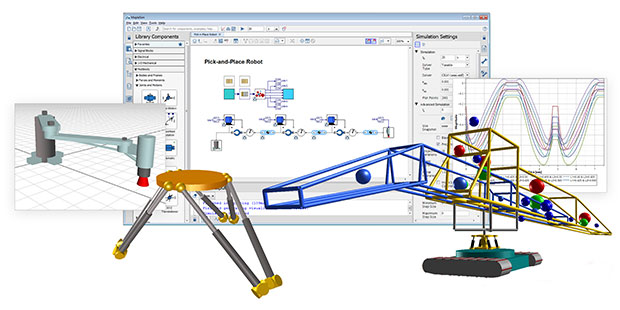Editor’s Pick: System-Level Modeling Tool Sees Major Update

Maplesoft has released the 2017 edition of MapleSim, its advanced system-level modeling tool. Deployed across a wide variety of applications and industries, MapleSim is known for its functionality for creating physics-based digital twins for virtual commissioning. Image courtesy of Maplesoft.
Latest News
October 18, 2017

Dear DE Reader:
Engineers and designers at all sorts of outfits use MapleSim to put their ideas and models for all kinds of applications through the optimization and in-the-loop test mill. So when Maplesoft rolls out a new edition of MapleSim, it’s take-notice news. That’s why today’s Editor’s Pick of the Week takes a look at MapleSim 2017.
MapleSim gets a lot of use throughout the design process when you’re modeling and testing multidomain systems since it’s fast, highly capable and not a hassle to use. Part of its speed lies with what Maplesoft calls “digital twins.” These physics-based, high-fidelity virtual prototypes don’t need test data to predict how your system will behave, which means you can get right down to designing concepts, validating performance, seeing the effect of changes and so on. MapleSim 2017 adds two new apps that should boost your productivity.
 Maplesoft has released the 2017 edition of MapleSim, its advanced system-level modeling tool. Deployed across a wide variety of applications and industries, MapleSim is known for its functionality for creating physics-based digital twins for virtual commissioning. Image courtesy of Maplesoft.
Maplesoft has released the 2017 edition of MapleSim, its advanced system-level modeling tool. Deployed across a wide variety of applications and industries, MapleSim is known for its functionality for creating physics-based digital twins for virtual commissioning. Image courtesy of Maplesoft.The first is the Initialization Diagnostics App. What it does is help you understand how initial values get computed and what you can do to adjust them. The second is a Modal Analysis App. This helps you study a mechanism’s natural vibration modes. With it, you can figure out which modes have an outsized impact on your design, which can help you determine how to reduce the vibration.
Another big enhancement in MapleSim 2017 is a new code editor for the Modelica standard for describing components and physical models. This should make life easier when you’re creating Modelica-based custom components. There also are new options to simplify making custom analysis tools.
MapleSim 2017 introduces an add-on component library, the MapleSim Heat Transfer Library from CYBERNET. This library helps you get the skinny on heat transfer effects in your model. Speaking of libraries, the Electrical and Magnetic libraries have more than 100 new components.
At about the time Maplesoft released MapleSim 2017, it announced a new standalone tool called MapleSim Explorer. It provides stakeholders direct access to MapleSim models and simulation results. Users can run simulations, change model parameters, investigate and plot model variables as well as view 2D simulation results and 3D simulation animations. Users also can analyze models using built-in MapleSim Apps like Parameter Sweep and Monte Carlo.
There’s much more going on with MapleSim 2017, and you can start learning about it in today’s Editor’s Pick of the Week write-up. You’ll find lots of links that will get you the full picture. Good stuff.
Thanks, Pal. – Lockwood
Anthony J. Lockwood
Editor at Large, DE
Subscribe to our FREE magazine, FREE email newsletters or both!
Latest News
About the Author
Anthony J. Lockwood is Digital Engineering’s founding editor. He is now retired. Contact him via [email protected].
Follow DE





